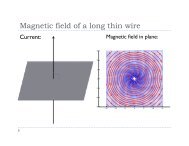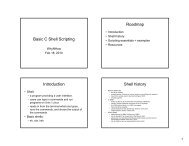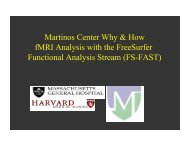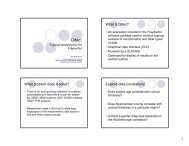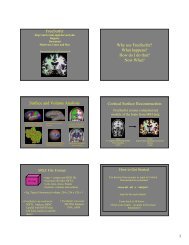Nuts & Bolts guide to MATLAB
Nuts & Bolts guide to MATLAB
Nuts & Bolts guide to MATLAB
- No tags were found...
Create successful ePaper yourself
Turn your PDF publications into a flip-book with our unique Google optimized e-Paper software.
<strong>Nuts</strong> & <strong>Bolts</strong> <strong>guide</strong> <strong>to</strong><br />
<strong>MATLAB</strong><br />
Adrian KC Lee ScD<br />
MGH-HST Athinoula A. Martinos Center for Biomedical Imaging;<br />
Department of Radiology, Harvard Medical School, Bos<strong>to</strong>n, MA.<br />
November 18 2010 | Why.N.How Tu<strong>to</strong>rial Series<br />
Friday, November 26, 2010<br />
1
Overview<br />
‣ Why do we use <strong>MATLAB</strong><br />
‣ Navigating in <strong>MATLAB</strong> environment.<br />
‣ Matrix Operations; Cell array; Structure.<br />
‣ General programming tips.<br />
‣ Simple <strong>MATLAB</strong> functions.<br />
‣ Error Flow / Debugging mode.<br />
‣ Plots / Graphs.<br />
Friday, November 26, 2010<br />
2
Why <strong>MATLAB</strong><br />
‣ <strong>MATLAB</strong> = MATrix LABora<strong>to</strong>ry<br />
• Basic data element is the matrix;<br />
• Vec<strong>to</strong>rized operations;<br />
• Good for generating engineering graphics.<br />
‣ Specialized Toolboxes.<br />
‣ Interacts with Inputs and Output devices.<br />
Friday, November 26, 2010<br />
3
<strong>MATLAB</strong> environment<br />
Current direc<strong>to</strong>ry<br />
Variables currently<br />
in Workspace<br />
Command prompt<br />
Command His<strong>to</strong>ry<br />
Friday, November 26, 2010<br />
4
Matrix Manipulations<br />
Review.m -<br />
Matrix Manipulations (1)<br />
‣ Matrix size: row x column<br />
• Basic data element is the matrix;<br />
‣ Vec<strong>to</strong>rs: a degenerate matrix<br />
• Row Vec<strong>to</strong>r = matrix with only 1 row<br />
- Separa<strong>to</strong>r used: , or <br />
• Column Vec<strong>to</strong>r = matrix with only 1 column<br />
- Separa<strong>to</strong>r used: ; or <br />
Friday, November 26, 2010<br />
5
Matrix Manipulations (2)<br />
‣ Element in matrix can be accessed:<br />
• A(row, column) = new_value;<br />
‣ Matrix Transponse<br />
• e.g., A’ (Note: Hermitian conjugate for Complex Field)<br />
- Separa<strong>to</strong>r used: , or <br />
‣ Sub-matricies:<br />
• Range specifies by :<br />
• Entire dimension selected by :<br />
Review.m -<br />
Matrix Manipulations (2)<br />
Friday, November 26, 2010<br />
6
Matrix Manipulations (3)<br />
‣ Math functions operate on matrices:<br />
Review.m -<br />
Matrix Manipulations (3)<br />
• Beware of commands used<br />
- e.g., * vs .* (matrix vs array multiply)<br />
• Reminder: Matrices are not commutative in<br />
multiplication, i.e., A*B ≠B*A<br />
‣ Solving system of linear equations:<br />
• Ax = b x = inv(A)*b or x = A\b<br />
‣ More math functions...<br />
Friday, November 26, 2010<br />
7
Array vs. Cell<br />
‣ Array: dimensions and types are consistent<br />
B_array = [‘abc,’,’d’;’ef’,’gh’];<br />
B_error = [‘abc’;‘defgh’];<br />
B_mix = [50,‘a’;’c’,70]<br />
char(50) = “2” and char(70) = “F”<br />
B_cell = {50,‘a’;’c’,70}<br />
=<br />
[50] ‘a’<br />
’c’ [70]<br />
Friday, November 26, 2010<br />
8
Array of Structures<br />
‣ Different data fields for each subject<br />
data = {‘KC’, 30, 10; ...<br />
‘Adrian’,25,23; ...<br />
‘Lee’,60,50};<br />
NAME = data(:,1)<br />
AGE = cell2mat(data(:,2))<br />
‣ Array of structures<br />
subject(1).name = 'KC';<br />
subject(1).age = 30;<br />
subject(1).mental_age = 10;<br />
subject(1).HDR = S01;<br />
subject(2).name = 'AA';<br />
subject(2).age = 25;<br />
subject(2).mental_age = 23;<br />
subject(2).HDR = S02;<br />
Warning: only an illustration. Not HIPPA kosher!<br />
Friday, November 26, 2010<br />
9
Control Statements<br />
‣ Conditional:<br />
Review.m -<br />
Control statements<br />
• Syntax<br />
if <br />
<br />
(elseif <br />
)<br />
else<br />
<br />
end<br />
Friday, November 26, 2010<br />
10
Control Statements (2)<br />
‣ Repetition:<br />
Review.m -<br />
Control statements<br />
• Looping with while<br />
while <br />
<br />
end<br />
• Looping with for<br />
for var = start:step:end<br />
<br />
end<br />
Friday, November 26, 2010<br />
11
General Computing Tips<br />
‣ Divide and Conquer.<br />
‣ Comments (both header and body).<br />
‣ Choose obvious (and not reserved) variable names.<br />
‣ Keep trace of different editions.<br />
‣ Concept of “Flags.”<br />
‣ Control flow of program (error messages).<br />
Friday, November 26, 2010<br />
12
<strong>MATLAB</strong> functions<br />
‣ Function declaration:<br />
fac<strong>to</strong>rial(2).m, comb(2).m<br />
function (output args) = ...<br />
(input args)<br />
‣ Save as an m-file (.m) using the exact function name<br />
for the filename.<br />
‣ Make sure that the path is added <strong>to</strong> the workspace<br />
<strong>to</strong> call function.<br />
Friday, November 26, 2010<br />
13
DEBUG mode<br />
‣ Debug > S<strong>to</strong>p if Errors / Warnings ><br />
• Access <strong>to</strong> variables in workspace<br />
• Step / Step In / Step Out <strong>to</strong> trace loop<br />
• (if no <strong>MATLAB</strong> errors, make one yourself <strong>to</strong> have<br />
access <strong>to</strong> DEBUG mode for tracing)<br />
• Use dbquit <strong>to</strong> exit debug mode<br />
Friday, November 26, 2010<br />
14
<strong>MATLAB</strong> plots<br />
‣ Basic 2-D <strong>MATLAB</strong> plotting command<br />
• plot(x,y,s)<br />
• x and y must be the same size<br />
• s is a string that can be used <strong>to</strong> denote color,<br />
symbol and line-type of the plot.<br />
• See also semilogx, semilogy, loglog,<br />
polar, fill, bar, errorbar, hist,<br />
plotyy, area, pie, stem, stairs etc.<br />
Friday, November 26, 2010<br />
15
Plotting (time domain)<br />
plot_example.m<br />
‣ Define time vec<strong>to</strong>rs <strong>to</strong> generate <strong>to</strong>nes and plots:<br />
• Syntax: start:step:finish<br />
• close all hidden, hold<br />
• figure creates a new figure.<br />
• subplot, xlabel, ylabel, title, axis,<br />
strcat, stem<br />
Friday, November 26, 2010<br />
16
References & other tips<br />
‣ www.mathwork.com/matlabcentral<br />
• File Exchange<br />
- Shared programs (e.g., errorbarxy)<br />
• <strong>MATLAB</strong> helpdesk<br />
‣ Linear Algebra Tu<strong>to</strong>rial<br />
• MIT OCW 18.06 Linear Algebra<br />
Friday, November 26, 2010<br />
17




